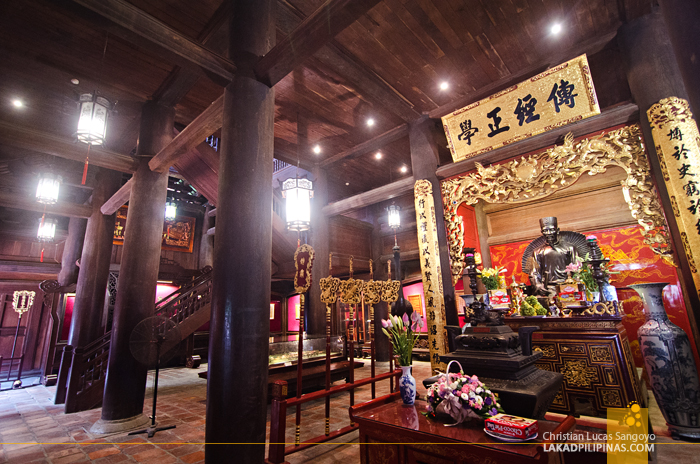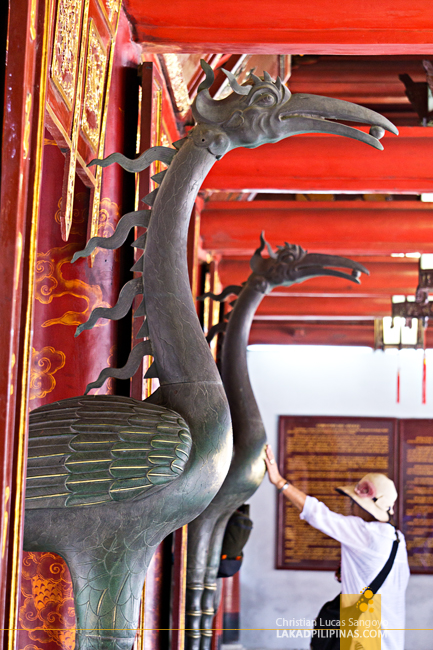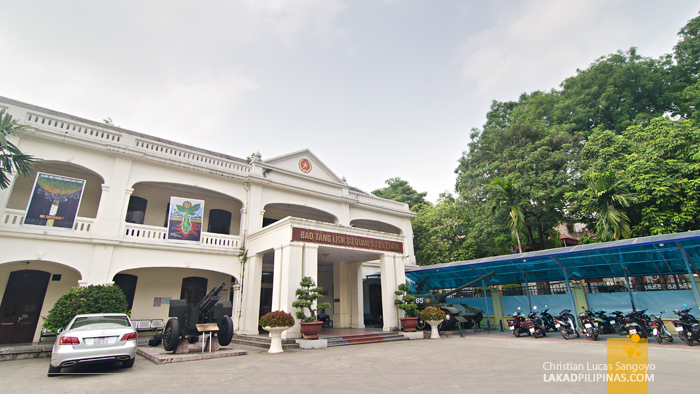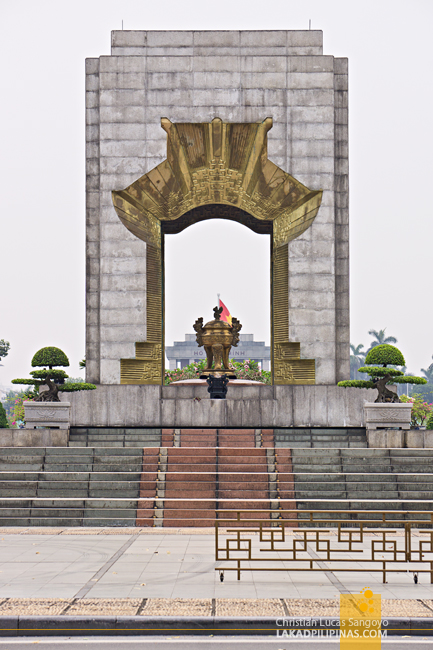VIETNAM | Hanoi’s Ba Dinh District, a DIY Walking Tour
Wednesday, August 30, 2017
After doing the requisite Hanoi Old Quarter and French Quarter walking tour, it’s time to see other parts of the city. And yes, there’s more to Hanoi than the places around Hoan Kiem District, and what’s nice about it is that these are all very walkable from Hoan Kiem Lake.
Ba Dinh District is mostly characterized by stately government buildings and wide tree-lined streets, a breather from the tight roadways of the Old Quarter. But besides these, it also has the most beautiful temples in Hanoi, even boasting of a certified UNESCO World Heritage Site.
Like the Hoan Kiem walking tour, this would take almost the whole day—check out my Hanoi Food Trip post for places where you can eat along the way. If you haven’t ran your soles to the ground just yet, then get your cameras and let’s see what the western side of Hanoi has to offer!
HANOI TRAIN STREET
ADDRESS: DIEN BIEN PHU ROAD, BA DINH DISTRICT, HANOI | OPENING HOURS: 24 HOURS DAILY | ENTRANCE FEE: NONE
Walking from either Hang Bong Street from the Old Quarter, or Trang Thi Road at the French Quarter, stop at the train tracks along the Dien Bien Phu Road and enter Hanoi’s Train Street. It’s a proper street—houses on both sides with kids playing along, people going about their daily routine on a narrow roadway reminiscent of those at the Old Quarter—the only difference is that there’s an actual train track right in the middle!
And yes, there’s an actual big-ass train that passes along this route, not once, but twice a day at 3:30PM and 7:30PM. The area is really narrow, so if you’re planning to catch the train, find a safe spot before the designated time, and watch the southern end of the rail for the incoming locomotive.


TEMPLE OF LITERATURE
ADDRESS: 58 QUOC TU GIAM STREET, BA DINH DISTRICT, HANOI | OPENING HOURS: 8:00PM - 6:00PM | ENTRANCE FEE: VND 30,000.00 (USD 1.50)
About 600 meters away from the train tracks is the Temple of Literature. Featured at the back of the 100,000 Vietnamese dong and the Starbucks City Icon mug, it is one of the most beautiful temples in Hanoi.
It was built in 1070 on a 54,000 square meter plot of land subdivided into five walled courtyards. The landscapes, well maintained and very serene, matches well with the ornate imperial Chinese architecture. It is dedicated to the teachings of Confucius, with the complex housing the first ever national university in Vietnam, Quốc Tử Giám, or the Imperial Academy. Its prominence fell when the capital was moved to the Imperial City of Hue, but its majesty remained.
It would take more than an hour to explore every nook and crannies of this place, so make sure you’d had breakfast before going in.




LENIN PARK
ADDRESS: 28A DIEN BIEN PHU STREET, BA DINH DISTRICT, HANOI | OPENING HOURS: 24 HOURS DAILY | ENTRANCE FEE: NONE
Head northwards and you’d find a park dedicated to Russia’s communist revolutionary leader, Vladimir Lenin. It’s a small park replete with trees, nothing really remarkable except for the Lenin statue. It’s not everyday that you get to see this guy’s likeness on parks across South East Asia.


VIETNAM MILITARY HISTORY MUSEUM
ADDRESS: 28 DIEN BIEN PHU STREET, BA DINH DIST. | OPEN HOURS: 8:00AM-4:30PM, CLOSED FRIDAY | ENTRANCE FEE: VND 30,000 (USD 1.50)
Right across the street, fronting Gospodin Lenin, is the Vietnam Military History Museum, or simply Army Museum. You actually won’t notice it, since it’s fronted by a nondescript two-story building, except for the MIG-21 jet fighter (it shot down fourteen US planes during the war) docked on its left flank.
Besides war relics displayed inside the museum, on its courtyard, you’d find a couple of planes, a chopper, wreckage of an American B-52 bomber, and the actual military tank that crashed through the gates of Saigon’s Presidential Palace which ended the Vietnam War in 1975.


HANOI FLAG TOWER
ADDRESS: LE HONG PHONG STREET, BA DINH DISTRICT, HANOI | OPENING HOURS: 9:00AM - 5:00PM | ENTRANCE FEE: VND 30,000.00 (USD 1.50)
Right beside the Army Museum is the iconic Hanoi Flag Tower. Rising to a height of forty one meters with a gigantic red Vietnamese flag dancing with the wind, it’s almost always visible along the Ba Dinh District. Built in 1812, more than 200 years from today, its octagonal tower stands on three brick platforms. It’s one of the rare architectural gems that weren’t destroyed during the French-colonial times in Vietnam.


IMPERIAL CITADEL OF THANG LONG
ADDRESS: HOANG DIEU STREET, BA DINH DIST. | OPEN HOURS: 8:30AM-5:00PM, CLOSED ON MONDAY | ENTRANCE FEE: VND 30,000 (USD 1.50)
From the flag tower, head north to see the Hanoi Citadel. Dubbed as the Imperial Citadel of Thang Long, it’s one of the seven UNESCO World Heritage Sites in Vietnam. The massive site served as the political center of Vietnam for thirteen consecutive centuries and the capital of the country for eight centuries. It has a long historical past, with archeological diggings unearthing 6th and 20th century artifacts—from foundations of old palaces to ancient roads, ceramics, and coins.
This place is massive and it would take a couple of hours to tour its grounds, it wholly deserves a separate article.

VIETNAM WAR MEMORIAL
ADDRESS: HOANG DIEU STREET, BA DINH DISTRICT, HANOI | OPENING HOURS: 24 HOURS DAILY | ENTRANCE FEE: NONE
A hundred meters away from the gates of Hanoi Citadel is the Dai Liet Si Quoc Gia. Directly translated, it means National Martyr’s Hall or more popularly known as the Vietnam War Memorial.
With massive blocks of stone carved with a traditional golden pagoda, its construction is a fusion of Vietnamese and modernist architecture. Constructed in 1993, it commemorates the sacrifices of its people during the bloody Vietnam War.

CUA BAC CHURCH
ADDRESS: 56 PHAN DINH PHUNG STREET, BA DINH DISTRICT, HANOI | OPENING HOURS: | ENTRANCE FEE: NONE
If you head straight along the highway, which we did not, you’ll arrive at the Cua Bac Church, one of the three major churches in Hanoi. Originally named as the Church of the Martyrs, it was built by the French in 1932 during the colonial period in Vietnam. A fusion in Art Deco and local Vietnamese architecture, it is characterized by a handsome belfry and massive rose windows on its front façade and transepts.
QUAN THANH TEMPLE
ADDRESS: THAN NIEN STREET, BA DINH DISTRICT, HANOI | OPENING HOURS: 7:00AM – 5:00PM | ENTRANCE FEE: VND 10,000.00 (USD 0.50)
Another place we missed, but were within striking distance of our Ba Dinh District walk, was the Quan Thanh Temple. It’s a Taoist temple built in the 11th century and one of the Four Sacred Temples in Hanoi. It was built over one of the four cardinal directions to protect the city from evil spirits.
TRAN QUOC PAGODA
ADDRESS: THAN NIEN STREET, BA DINH DISTRICT, HANOI | OPENING HOURS: 7:00AM – 5:00PM | ENTRANCE FEE: VND 10,000.00 (USD 0.50)
And yet another one we missed, the Tran Quoc Pagoda. It’s about 300 meters from the Quan Thanh Temple, jutting over Hanoi’s gigantic West Lake. The Buddhist temple is set on a causeway on the east side of the water and features an eleven-storey red pagoda where monk’s ashes are reverently kept.
The temple was constructed in the 6th century, making it the oldest pagoda in Hanoi. Besides its structures, one of the more important things to see inside the complex is a Bodhi tree, a cutting of the original tree in India where Buddha sat and achieved nirvana. It was a gift by Indian president Rajendra Prasad in 1959.
The best time to actually go here is during sunsets, so should you prefer to, you can go to the Ho Chi Minh Mausoleum and its nearby attractions first before going here to make this your final destination of the tour.
HANOI PRESIDENTIAL PALACE
ADDRESS: HUNG VUONG STREET, BA DINH DISTRICT, HANOI | OPENING HOURS: 7:30AM - 1:30PM | ENTRANCE FEE: VND 25,000.00 (USD 1.25)
Painted in bright yellows, Hanoi’s Presidential Palace can be viewed only from the wrought iron gates outside the compound. Or that’s what we thought. It turned out visitors can actually tour the ground, but not enter the palace itself. It was constructed in Italian Renaissance style by the French.
It was said that Ho Chi Minh refused to live in the palace during his time, preferring to live on a traditional Vietnamese stilt house that he asked to be built within the same grounds.


HO CHI MINH MAUSOLEUM
ADDRESS: HUNG VUONG STREET, BA DINH DISTRICT, HANOI | OPENING HOURS: 8:00AM – 5:00PM | ENTRANCE FEE: NONE
Ho Chi Minh’s final resting place is the centerpiece of Ba Dinh District. Located on Ba Dinh Square, the structure, clad in grey granite, was inspired by Lenin’s in Moscow. It was built in 1975 with a height of 21.6 meters; it’s both regal and imposing. The embalmed body of the Vietnamese leader is preserved inside the hall where visitors are allowed to enter, it was just unfortunate that it was closed when we visited.



ONE PILLAR PAGODA
ADDRESS: CHUA MOT COT STREET, BA DINH DISTRICT, HANOI | OPENING HOURS: 7:30AM - 1:30PM | ENTRANCE FEE: VND 25,000.00 (USD 1.25)
And like an encore, the final destination for our Ba Dinh District tour is the One Pillar Pagoda. It is located just beside the Ho Chi Minh Mausoleum, hidden behind a wall.
We were actually looking for a pagoda within the vicinity, thinking, we could not possibly miss a pagoda in such an open environment. Well, we failed in finding it. The reason? It was so small! The Buddhist pagoda, built in 1049, stands at a mere four meters! But still, it is considered as one of the two most iconic temples in the whole of Vietnam.

► BOOK ONLINE FOR DISCOUNTED TOURS IN HANOI ◄



























































0 comments